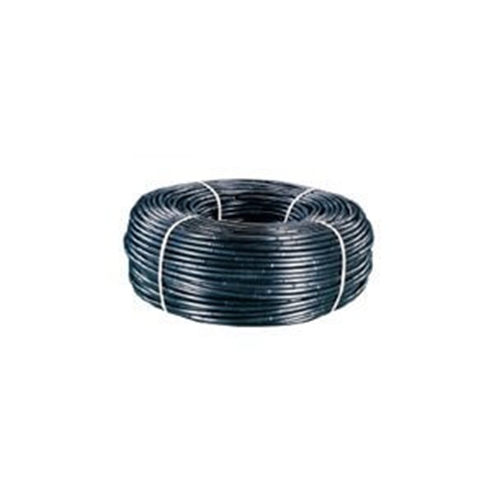General features
Drip irrigation is the irrigation method in which purified water and fertilizer are given to the soil surface or into the soil (plant root zone) in a very small but continuous flow or drops through drippers. This method finds an increasing usage area every day because it provides water savings by using irrigation water at high efficiency, keeps the soil moisture at the desired level and allows the plants to be given the necessary nutrients with water.
The drip irrigation method provides high irrigation efficiency, has a low pressure requirement for water distribution, does not require leveling work in uneven places, allows the control of salt in soil water, and enables continuous water delivery through high irrigation frequency circuits. Thanks to the drip irrigation method, wetting of the upper parts of the plants is prevented, the air humidity is not affected much by irrigation, the soil surface between the plant areas remains dry.
An ideal drip irrigation is possible by providing an equal amount of water output from all drippers. Thus, it is ensured that every plant reaches as equal amount of water as possible during the irrigation period. The high uniform water distribution in drip irrigation reduces the amount of water that will leak deeply from the root zone and ensures that the amount of water required by the plant is delivered to the root zone.
With drip irrigation, the formation of a creamy layer in the soil is prevented, the water losses caused by evaporation are reduced, and the possibility of automatic control is enabled. The drip irrigation method requires a low level of labor and operating costs are low in this method.
Production Features
Drip irrigation pipes are produced from PE raw material in extruder lines. A dripper is placed inside the pipe during production. This dripper reduces the pressure of the water with its labyrinth structure, thus allowing the water to go out of the pipe in the form of drops. Drippers are placed inside the pipe at different distances according to the planting intervals of the plants. It is packaged in coils and the user cuts and uses at desired intervals. Dizayn Group produces four different types of drip irrigation pipes:
- Flat Drip Irrigation Pipes
- Round Drip Irrigation Pipes
- Round Pressure Adjustable Drip Irrigation Pipes
- Oval Drip Irrigation Pipes
Flat Drip Irrigation
- Pipes made of original polyethylene raw material have high resistance to elongation, shrinkage and rupture.
- It is produced between 16-20-22mm diameters and between 6 and 35 MIL (0.15-0.9mm) wall thickness.
- There are 4 different flow rate settings as 1-1,3-1,6-2 liter / hour at 1 atm pressure.
- Maximum Line Lengths (Meters) 1 Bar Operating Pressure
Round Drip Irrigation
- Pipes made of original polyethylene raw material guarantee the best results.
- It is produced in 16-20mm diameters.
- 20-25-30-40-50-60-75-100 cm dripper ranges are standard productions. If desired, production can be made in different dripper ranges.
Advantages
- It saves water.
- It prevents the salinization of the soil.
- It ensures that the plant is given as much water as it needs.
- Since the water source is close to the plant, the plant spends its energy on stem and product development rather than root development.
- It prevents the reproduction of wild plants by irrigating the soil other than plants.
- Efficient work can be done since the soil is not muddy.
- As the fertilizer is dissolved in water, it reaches the plant directly and the consumption amount of the fertilizer is reduced.
- There is no disproportionate watering of the plants due to the slope.
- The flower of the plant is not affected by irrigation.
- It is very easy to collect, stock and re-install.
- Clogging possibility is minimal thanks to specially designed drippers.
- Provides longer laying opportunity due to its smooth inner surface.
- It saves pesticides, fertilizers and labor.
- Since the system operates with low pressure, energy costs are minimum.
System Control Unit
1. Pump Unit:
0-1.5 atm needed in drip irrigation systems. The output information of the pump is at least 2-2.5 atm. Different types of pumps can be used depending on the type of water source.
2. Control Unit:
This unit is used to clean water and transport nutrients to the plant and consists of the following elements.
a. Hydrocyclone: It is the discharge control unit element of the sand pieces that are in the irrigation water and are heavier than the water.
b. Sand-Gravel Filter Tank: It is the control unit element used to filter objects such as algae, insects, sediment that are lighter than water and will be found when the irrigation water will be supplied especially from lakes, stream beds and ponds.
c. Fertilizer Tank: It is the control unit element where the nutrients needed by the irrigation plant are mixed with irrigation water and sent to the plant.
D. Sieve or Disc Filter: It is the control unit element in which the sediment that cannot be filtered in the sand and gravel filter tank and the fertilizers that may come from the fertilizer tank are kept.
3. Pipelines and Drippers:
a. Main Pipe: PE100 used with Ø 32 - Ø 160 mm diameter is used.
b. Manifold Pipe: It is used to distribute laterally from the main pipe and to the drippers. They are PE 100 coil pipes with a range of Ø 20 - Ø 75 mm.
c. Lateral Pipes: These are Ø 16 and Ø 20 mm drippers laid parallel to the plant row.
Operation of drip irrigation system
There are some points that should be considered during the operation of the drip irrigation system:
- How many operating units the drip irrigation system consists of, how to plan the irrigation time in each unit (when to start irrigation and how much irrigation water will be given or how many hours of irrigation) should be known.
- If there is rain, it should be known how many days the irrigation will be delayed according to the amount of rainfall.
- In determining when to start irrigation, the water consumption values of the plant can be used or tools such as tensiometer showing the moisture level in the soil can be used.
- To prevent the drippers in the drip irrigation system from clogging; Filters should be cleaned and maintained periodically, dilute acid (such as hydrochloric or ortho-phosphoric acid) should be applied several times during the irrigation season and after the last irrigation.
- In order to obtain high and high quality yield from the plant irrigated with drip irrigation, the macro and micro nutrients required by the plant should be mixed with the irrigation water when and in the amount needed by the plant.
- Fertigation, which means that fertilizers are dissolved in water and given with irrigation water, prevents fertilizer washing, water and soil pollution is reduced, effective use of fertilizers is ensured, root zone salinity due to fertilizers is reduced to low levels, the plant benefits from fertilizer and irrigation water at the highest level, time, labor, tools and energy are saved and high efficiency can be achieved.







